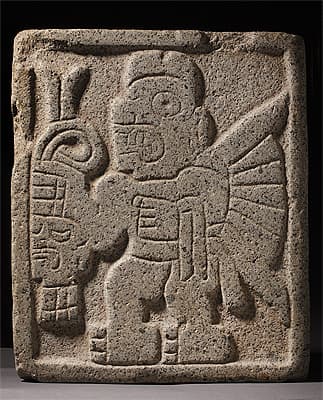
CHAVÍN culture Northern Highlands 1500 BC – 200 BC
Winged deity holding a severed head c. 1000 BC granite50.5 (h) x 42.3 (w) x 12.0 (d) cm Fundación Museo Amano, Lima Photograph: Daniel Giannoni
Chavín ruler-priests identified themselves with powerful predatory creatures such as large birds and wild cats. Humans were transformed into gods with the wings of harpy eagles and jaguar fangs. This mystical process was stimulated by the ceremonial use of psychotropic drugs like coca. The Chavín built large stone temples for their rituals, decorating them with scenes such as this carved plaque showinga deity holding the decapitated head of an enemy captive.
Chavín ruler-priests identified themselves with powerful predatory creatures such as large birds and wild cats. Humans were transformed into gods with the wings of harpy eagles and jaguar fangs. This mystical process was stimulated by the ceremonial use of psychotropic drugs like coca. The Chavín built large stone temples for their rituals, decorating them with scenes such as this carved plaque showinga deity holding the decapitated head of an enemy captive.
Chavín ruler-priests identified themselves with powerful predatory creatures such as large birds and wild cats. Humans were transformed into gods with the wings of harpy eagles and jaguar fangs. This mystical process was stimulated by the ceremonial use of psychotropic drugs like coca. The Chavín built large stone temples for their rituals, decorating them with scenes such as this carved plaque showinga deity holding the decapitated head of an enemy captive.

